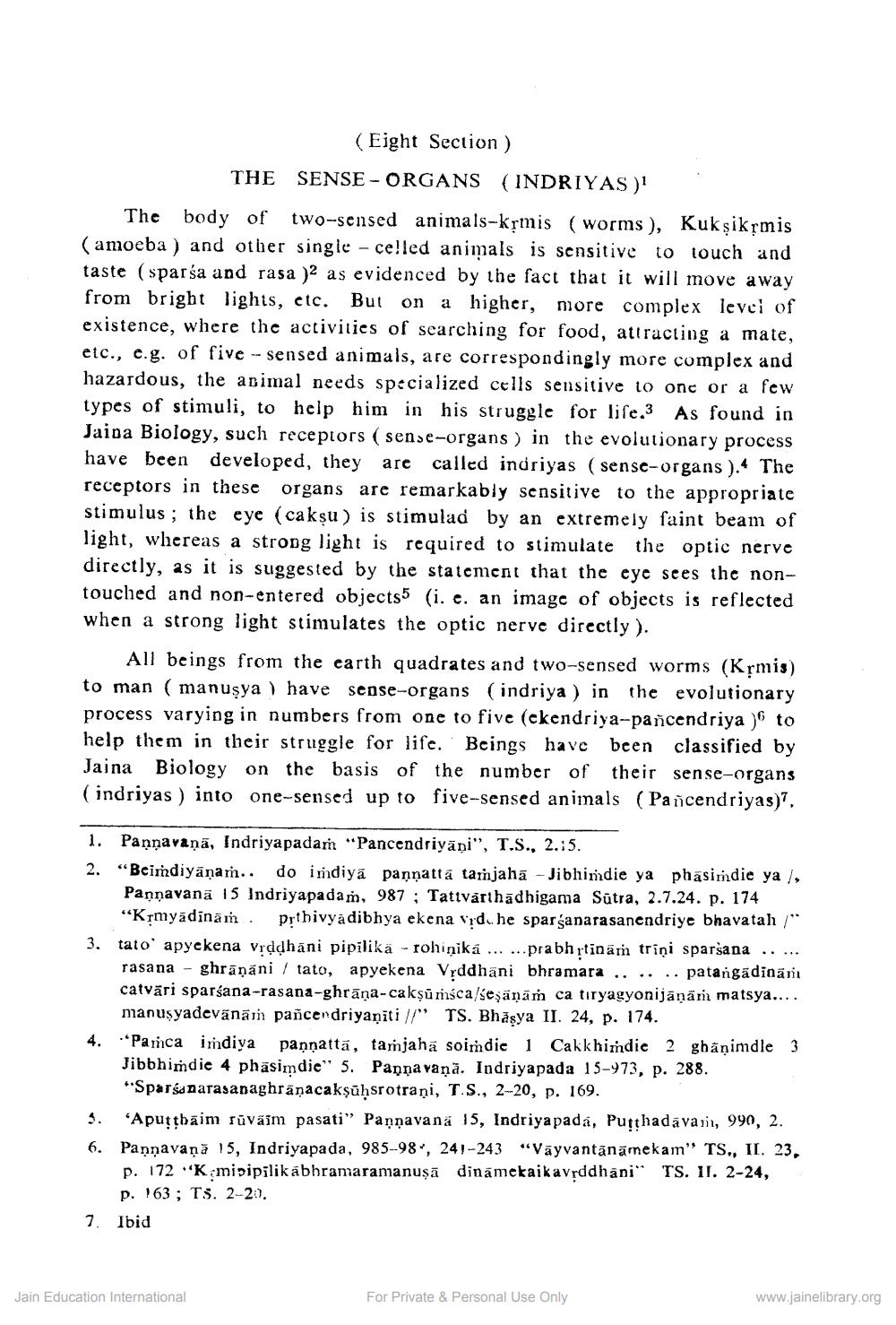________________
(Eight Section ) THE SENSE -ORGANS (INDRIYAS)' The body of two-sensed animals-krmis (worms), Kuksikrmis (amoeba ) and other single - celled animals is sensitive to touch and taste (sparsa and rasa )2 as evidenced by the fact that it will move away from bright lights, etc. But on a higher, more complex level of existence, where the activities of searching for food, attracting a mate, etc., e.g. of five -- sensed animals, are correspondingly more complex and hazardous, the animal needs specialized cells sensitive to one or a few types of stimuli, to help him in his struggle for life.3 As found in Jaipa Biology, such receptors ( sense-organs ) in the evolutionary process have been developed, they are called indriyas ( sense-organs ).4 The receptors in these organs are remarkably sensitive to the appropriate stimulus; the eye (cakşu) is stimulad by an extremely faint beam of light, whereas a strong light is required to stimulate the optic nerve directly, as it is suggested by the statement that the eye sees the nontouched and non-entered objects (i. e. an image of objects is reflected when a strong light stimulates the optic nerve directly ).
All beings from the earth quadrates and two-sensed worms (Krmis) to man ( manuşya ) have sense-organs (indriya ) in the evolutionary process varying in numbers from one to five (ckendriya--pancendriya ) to help them in their struggle for life. Beings have been classified by Jaina Biology on the basis of the number of their sense-organs (indriyas) into one-sensed up to five-sensed animals (Pañcendriyas).
1. Pannavaņā, Indriyapadam "Pancendriyāni", T.S., 2.:5. 2. "Beimdiyānam.. do indiyā pannatta tamjaha - Jibhindie ya phasimdie ya ),
Pannavanā 15 Indriyapadam, 987 ; Tattvarthadhigama Sutra, 2.7.24. p. 174
“Kṣmyadinam. Prthivya dibhya ekena Vyd he sparsanarasanendriye bhavatah /" 3. tato' apyekena Vrddhani pipilika - rohinika ... ...prabhrtinar triņi sparsana .....
rasana - ghrāņāni / tato, apyekena Vrddhani bhramara .. .. .. patangadinän catvāri sparśana-rasana-ghrāņa-cakşū mscasezāņāṁ ca tiryagyonijāņār matsya....
manușyadevānāın pañcerdriyaniti //" TS. Bhāşya II. 24, p. 174. 4. Pamca indiya pannatta, tamjaha soindic 1 Cakkhindie 2 ghānimdle 3
Jibbhimdie 4 phasimdie" 5. Pannavaņā. Indriyapada 15-973, p. 288.
"Sparśanarasanaghrânacakşūhsrotrani, T.S., 2-20, p. 169. 3. Apuţtbäim rūVāim pasati” Pannavaná 15, Indriyapada, Pusthadavari, 990, 2.
Pannavaņā 15, Indriyapada, 985-98', 241-243 “Vayvantānāmekam" TS., II. 23, p. 172 Kimipipilikábhramaramanuşādināmekaika Vrddhani" TS. 11. 2-24,
p. !63; TS. 2-20. 7. Ibid
Jain Education International
For Private & Personal Use Only
www.jainelibrary.org




